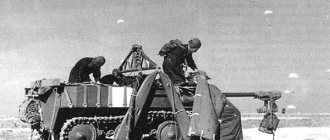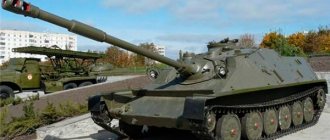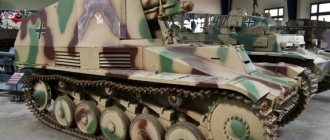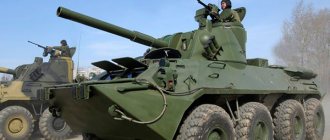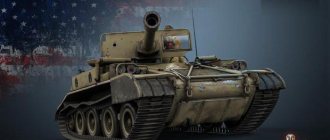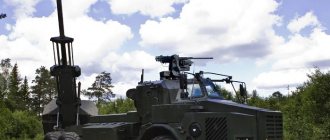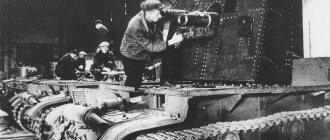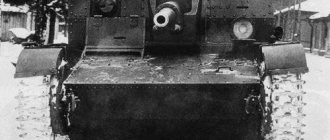The self-propelled artillery unit (SPG), or in colloquial language simply self-propelled gun, appeared along with the first tanks. According to modern classification, the first French tanks “Schneider” and “Saint-Chamon” are not tanks. These are ordinary field guns mounted on self-propelled chassis and protected by thin armor. The difference between a tank and a self-propelled gun is that the tank is equipped with its own weapon, developed specifically for this tank. In addition, self-propelled guns, as a rule, are not equipped with additional weapons (machine guns, mortars, anti-aircraft guns, etc.).
The first self-propelled guns appeared before the First World War, but did not receive full-scale distribution. The real heyday of self-propelled guns came during World War II. But we will talk about the Gvozdika self-propelled gun, which was put into service in 1970 and has not yet been removed from combat duty.
History of creation
Assault and anti-tank self-propelled guns appeared in service with the USSR army in the 1940s. It cannot be said that they made a decisive contribution to the victory (the championship still belongs to tanks), but they were very effective in supporting infantry and advancing tanks. With the beginning of the Cold War, the potential enemy acquired sophisticated 105 mm artillery systems, which were superior to Soviet self-propelled guns in many respects.
But the USSR doctrine was aimed at the use of missiles and self-propelled guns were not developed. After Khrushchev left office, a doctrine emerged among sober minds that a global nuclear war was impossible. The possibility of destroying not only the enemy, but also oneself is too great. But the use of destructive weapons for tactical purposes is quite likely. In this sense, the use of self-propelled guns was one of the best ways to deliver a tactical nuclear charge to the right place.
Based on this statement, the development of a new self-propelled gun, called the 2S1 “Gvozdika” self-propelled gun, began, taking into account the possibility of using such charges.
By the decision of the Communist Party and the decree of the Union government, the development of a 122 mm caliber artillery system began in 1967.
This decision was based on the research base of VNII-100. It was these studies that determined the basic characteristics of the future self-propelled howitzer.
The research institute proposed three chassis options: BMP-1, MT-LB tractor and Object-124. They chose a tractor, on the basis of which the Gvozdika self-propelled gun was designed. The tractor plant in Kharkov was tasked with developing a new system.
1969 began testing four prototypes of 122 mm Gvozdika and 152 mm 2S3. The choice was made on the Gvozdika. In 1970, the USSR government, after a year of testing and necessary modifications, adopted the Gvozdika self-propelled gun.
The new self-propelled gun began to arrive in military units, and the crews gradually mastered this system. Serial production was finally mastered in 1971. It was produced in Poland (since 1971) and Bulgaria (since 1979). In 1991, the self-propelled gun was no longer produced. In total, about ten thousand cars have been produced since 1970.
Performance characteristics of the SU-5 self-propelled gun
— Developer: Design Bureau of Plant No. 185 — Manufacturer: Plant No. 174 named after Voroshilov — Years of development: 1933—1934 — Years of production: 1936—1938 — Years of operation: 1938—1941 — Number of produced, pcs.: 33 — Layout diagram: T- 26 — Crew, people: 5
Weight of self-propelled gun SU-5
-Combat weight, t: 10.5
Overall dimensions of self-propelled gun SU-5
— Body length, mm: 4840 — Width, mm: 2440 — Height, mm: 2560 — Ground clearance, mm: 380
Reservation of self-propelled guns SU-5
— Hull front, mm/deg.: 15 — Hull side, mm/deg.: 10 — Hull rear, mm/deg.: 10 — Bottom, mm: 6 — Hull roof, mm: 6 — Gun shield, mm/deg. .: 15
Armament of self-propelled gun SU-5
— Caliber and brand of gun: 122-mm howitzer 1910/30 — Type of gun: howitzer — Gun ammunition: 8 shots — Sights: telescopic sight and Hertz panorama
Engine self-propelled gun SU-5
— Engine type: T-26, carburetor — Engine power, l. p.: 90
Speed of self-propelled gun SU-5
— Highway speed, km/h: 30
— Cruising range on the highway, km: 170 — Climbing grade, degrees: 32° — Climbing wall, m: 0.9 — Climbing ditch, m: 2.5 — Climbing ford, m: 0.8
Design
The layout of the body of this artillery system was made according to the turret design. Everything is welded from rolled steel sheets. The body itself is absolutely sealed, and the thickness of the armor plates is 20 mm. This is fairly reliable protection against shrapnel and bullets, but not against shells. The engine compartment is located on the right side, where the driver-mechanic seat is also located.
The fighting compartment is located in the middle and stern. There is a turret on the hull, and a gun in it. There are charges and loader in the turret on the right side. On the left is the gunner and sight for precise aiming. The commander's place is behind the gunner. The commander has his own rotating turret with a hatch for visual control. In the niche of the tower itself, cumulative shells and charges for them are placed. The remaining ammunition is located at the stern.
The 2S1 self-propelled gun has a special hatch through which it is possible to receive shells directly from the ground.
Chassis. It is based on a modified MT-LB chassis. It was well redesigned, installing a couple of additional road wheels. But the number of rubberized skating rinks has increased to seven pairs. There are guide wheels at the rear and driving wheels at the front. The caterpillar is assembled from links (tracks). The links are quite small (350*111), connected by metal fingers.
With a track width of 350 mm and a weight of 15.7 tons, the machine feels confident on any ground. The Gvozdika artillery system has an individual torsion bar suspension. Hydraulic shock absorbers are installed on the seventh and first road wheels.
Engine and transmission. The vehicle is equipped with a YaMZ-238N engine with a power of 300 hp. Runs on diesel fuel. The engine is V-shaped, 8-cylinder, four-stroke, liquid-cooled. Gas turbine supercharging. As for the transmission, it is dual-flow and mechanical. There are two rotation mechanisms and they are planetary-friction. There are six forward gears and one reverse gear.
Armament. The 122 mm rifled howitzer is the basis of the installation's firepower.
The muzzle brake, ejector, breech and pipe are connected into a barrel more than 4 meters long. There are 34 grooves inside the barrel. This weapon uses a vertical wedge bolt. There is a semi-automatic re-cocking mechanism.
To prevent the projectile from falling out in cases where the barrel is at high elevation angles, a special tray with a retention device is installed.
The recoil device has a special hydraulic brake, of the spindle type. There is also a pneumatic knurling device with air or nitrogen filling. A compensator is installed on the rollback brake.
Surveillance and communication equipment. TKN-3B, a sight that is located on the commander's seat. The OU-3GA2 sight is installed to carry out night surveillance of the area. TNPO-170A, a periscope, prismatic type sight, and 1OP40 panoramic type, both are located at the gunner's position. OP5-37, for firing from cover. The MK-4 rotating type is located on the right side of the turret. The mechanic has a TNPO-170A device for observation during the day and a TVN-2B for night observation.
At the driver-mechanic's place there is a glass with an armored cover for direct observation of the terrain. R-123M radio station with the help of which external communication is carried out. It operates on VHF waves, with a range of up to 28 km. For communication between the crew, the R-124 device is installed in the self-propelled gun.
Chassis Specifications
- The powerful diesel engine YaMZ-238N, which has proven itself in the Gvozdika, has a power of 300 hp. With. The dual-flow transmission features a six-speed front gearbox plus one rear gearbox.
- The weight of the self-propelled gun 2S34 is 16 tons.
- The BS ML-TB can reach a speed of 60 km/h on an asphalt road.
- On off-road and dirt roads, the speed is almost two times lower, 26 and 32 km/h, respectively,
- Speed on the pond is 4.5 km/h.
- Fuel tanks are designed for 500 km without additional refills.
- Dimensions of the "Khosta" - 7260 mm (7570 mm with a gun barrel) x 2850 mm x 2827 mm.
Performance characteristics of "Gvozdika" and foreign analogues
The tactical and technical characteristics of the installation are most evaluated in comparison with other self-propelled guns of a similar type.
| TTX | Self-propelled gun 2S1 “Gvozdika” | M-108 (USA) | Type-86 (Japan) | AMX-105V (France) |
| Year of issue | 1970 | 1962 | 1974 | 1960 |
| Weight, t | 15,7 | 21 | 16,5 | 17 |
| Crew, people | 4 | 5 | 6 | 5 |
| Caliber, mm | 122 | 105 | 122 | 105 |
| Ammunition, height Firing range, km | 40 | 86 | 40 | 37 |
| Firing range, km | 15 | 11,5 | 15 | 15 |
| Speed, km/h | 60 | 56 | 60 | 60 |
As can be seen from the performance characteristics of the Gvozdika, it was in no way inferior to its foreign counterparts. As can be seen from the table, the Japanese Self-Defense Forces had a similar vehicle only 4 years later.
SAU 2S1 Gvozdika 122 mm Firing range. Dimensions. Device. Weight
The self-propelled gun 2S1 “Gvozdika” was created in 1969 at OKB-9 two years after the resolution of the Council of Ministers was issued. During the fighting during the Great Patriotic War, self-propelled guns performed the same functions as tanks, so after the war they were supplanted for a long time by more effective, albeit expensive, tanks. It was only in 1965 that self-propelled artillery was revived, when designers began work on creating a new generation of self-propelled guns.
Modifications of "Gvozdika" and vehicles based on
The following options have been created based on the machine:
- 2S15 “Norov”, with a 100 mm gun, was intended to fight tanks, but when a prototype was created in 1983, and the need for this type of self-propelled guns disappeared;
- 2S17 “Nona-SV”, a self-propelled gun with a 120 mm gun, did not reach mass production;
- 2S8 “Astra” is a self-propelled mortar, its development was carried out in the 1970s, but all work on this mortar was closed in 1977, as they switched to the creation of the 2S17 “Nona-SV” artillery system
Of the modifications of this system, the following installations are best known:
- Raad-1, self-propelled gun, developed in Iran, this version uses an infantry fighting vehicle chassis, gun caliber 122 mm;
- 2S34 “Khosta” was created in 2003 in Russia, it was equipped with a 2A80-1 howitzer and a PKT machine gun in the commander’s cupola, and was adopted by the Russian Armed Forces in 2008;
- 2S31 “Vena”, 120-mm self-propelled artillery gun, sea trials in 2007, adopted by the Russian Armed Forces;
- Rak-120, a 2009 Polish self-propelled gun variant that uses a 120mm mortar instead of a howitzer;
- Model 89, this is the Romanian version of the Carnation;
- The 2C1T Goździk, a Polish reworking of the classic Soviet self-propelled gun, uses an automatic fire control system.
In 2015, Ukraine planned to improve the Gvozdika by installing a Volvo engine, as well as more advanced control and communication systems.
Performance characteristics of the SU-5 self-propelled gun
— Developer: Design Bureau of Plant No. 185 — Manufacturer: Plant No. 174 named after Voroshilov — Years of development: 1933—1934 — Years of production: 1936—1938 — Years of operation: 1938—1941 — Number of produced, pcs.: 33 — Layout diagram: T- 26 — Crew, people: 5
Weight of self-propelled gun SU-5
-Combat weight, t: 10.5
Overall dimensions of self-propelled gun SU-5
— Body length, mm: 4840 — Width, mm: 2440 — Height, mm: 2560 — Ground clearance, mm: 380
Reservation of self-propelled guns SU-5
— Hull front, mm/deg.: 15 — Hull side, mm/deg.: 10 — Hull rear, mm/deg.: 10 — Bottom, mm: 6 — Hull roof, mm: 6 — Gun shield, mm/deg. .: 15
Armament of self-propelled gun SU-5
— Caliber and brand of gun: 122-mm howitzer 1910/30 — Type of gun: howitzer — Gun ammunition: 8 shots — Sights: telescopic sight and Hertz panorama
Engine self-propelled gun SU-5
— Engine type: T-26, carburetor — Engine power, l. p.: 90
Speed of self-propelled gun SU-5
— Highway speed, km/h: 30
— Cruising range on the highway, km: 170 — Climbing grade, degrees: 32° — Climbing wall, m: 0.9 — Climbing ditch, m: 2.5 — Climbing ford, m: 0.8
Combat use
The self-propelled gun went through several local conflicts, the first of which was Afghanistan. In this war, as a rule, self-propelled guns were used to suppress enemy fire with direct fire, this significantly reduced troop losses. The most successful operations using the installation were carried out during the capture of Shingara, Khaki-Safed, and also in 1986, during the offensive on Kandahar.
In Chechnya, both military companies used the Gvozdika actively during combat operations and successfully coped with the assigned tasks.
The self-propelled gun was used in the Transnistrian conflict, in Yugoslavia, in southeastern Ukraine, by both warring parties. During the Iran-Iraq War, 2S1 and 2S3 were used by the Iraqi army.
During the civil war in Libya in 2010–2011, government forces actively used the device against the rebels.
The war in Syria has revealed the use of this installation by almost all warring parties, both government forces and various terrorist groups, including ISIS. The installation is used by the Houthis in Yemen in the fight against the invaders who have invaded the country.
Chassis Specifications
- The powerful diesel engine YaMZ-238N, which has proven itself in the Gvozdika, has a power of 300 hp. With. The dual-flow transmission features a six-speed front gearbox plus one rear gearbox.
- The weight of the self-propelled gun 2S34 is 16 tons.
- The BS ML-TB can reach a speed of 60 km/h on an asphalt road.
- On off-road and dirt roads, the speed is almost two times lower, 26 and 32 km/h, respectively,
- Speed on the pond is 4.5 km/h.
- Fuel tanks are designed for 500 km without additional refills.
- Dimensions of the "Khosta" - 7260 mm (7570 mm with a gun barrel) x 2850 mm x 2827 mm.
Interesting Facts
For all its weight and size, the self-propelled gun is capable of swimming, but the developers guarantee to overcome a water obstacle 300 m wide with a wave of no more than 15 cm, while the vehicle reaches a speed of up to 4.5 km/h. All this is thanks to the hermetic body and tracks, which in this version of movement act as blades.
The howitzer uses a wide variety of projectiles for firing, in addition to cumulative, high-explosive fragmentation, smoke, chemical, electronic countermeasures and projectiles with a swept-shaped striking element can also be used. And even lighting and propaganda.
The relatively light weight allows the self-propelled gun to be transported on Il-74 and An-12 aircraft.
And also on landing ships. “Gvozdika” was in service with all the armies of the countries that were part of the Warsaw Pact. In many of them it is still in service.
For this artillery system, a special laser-guided projectile “Kitolov-2” was developed, which is capable of hitting the target with high accuracy using a homing head. The projectile is highly accurate, but the target must be illuminated by a laser beam from the gun mount itself or by a fire spotter.
The Croats developed a “super charge” charge, thanks to which Gvozdika shells flew 17.1 km.
In 1997, a high-explosive fragmentation rocket was developed and tested for the Gvozdika. The firing range increased to almost 22 km.
What is a howitzer
The word "howitzer" comes from the German haubitze. Translated, this means a weapon that is designed to throw stones. If we talk about an artillery gun, a howitzer is a military device for firing at ground targets at an angle of 70 degrees. If you open a dictionary, the meaning of this word is described in different ways, but the basic meaning does not change.
A howitzer is the same gun, but with a shorter barrel length. The speed of the projectile at the beginning of its movement is also inferior to the speed of the cannon. The walls in the howitzer barrel are made thinner. If these two guns have the same caliber, then their weight is significantly different. The gun is much heavier.
The Gvozdika self-propelled gun is an artillery system that is still used by the armed forces of various countries.
Peculiarities
To relieve pressure during operation of the 122-mm self-propelled howitzer 2S1 “Gvozdika” in various temperature conditions, a spring compensator is provided on the recoil brake. The element cylinders are fixed in the breech. The maximum rollback length is 60 centimeters. The pipe interacts with the cradle, which includes a pair of clips. In the front one there is a casing with recoil cylinders.
In the middle there are fastenings for the armor shield with trunnions. There is a fence installed at the back of the cradle. On the right cheekpiece there is a device for stopping the manual release of the gun for the crew commander, and on the left there is a lever assembly with mechanical control. A folding fence with an electromechanical forwarding device is mounted between the cheeks.
Advantages of edition 3.0 "1C: Accounting 8"
All accountants have been waiting for this decision for the last 5 years, but they still delayed it. Should I still move on?
Yes. Users are recommended to finally upgrade to the modern version 3.0. Software products, including edition 3.0 of the Enterprise Accounting configuration, have actually been on sale for more than six years, they have been tested in practice, are reliable and are constantly being developed.
The transition from 1C:Accounting 2.0 to 3.0 is probably not easy, at least morally. What are the benefits of doing all this in 3.0?
The most important thing is that it is modern and convenient - when you switch to edition 3.0, you will have the opportunity to work with 1C: Accounting not only in local mode, but also in
To work, you only need the Internet, which means that you can, for example, easily switch to remote work, which is important in the context of the coronavirus pandemic. You can work in a hotel, country house, or in another city without any worries
In the conditions of coronavirus (and in general!) it is convenient not to be tied to an office workplace.
Cheat sheet on the article from the editors of BUKH.1S for those who do not have time
1. Stops supporting edition 2.0 of the “Enterprise Accounting” configuration.
2. Limited support for version 2.0 of the basic version will be provided until March 2022, and PROF - until March 2022.
3. When switching to edition 3.0, it will be possible to work with 1C: Accounting not only in local mode, but also in the 1C: Fresh cloud service.
4. For entrepreneurs who do not want to delve deeply into accounting, edition 3.0 has special features.
5. The transition to the local version of edition 3.0 is free for users. The transition to the cloud version in the 1C:Fresh service is paid for users of the basic version.
6. There are several options for migrating from edition 2.0 to 3.0, including automatic configuration updates for those who have not made any changes to it.
At the same time, nothing needs to be installed on your computer; even the electronic signature key for submitting reports via the Internet can be stored in the cloud. And it is safe, confidentiality and data storage is ensured. You do not need to spend your resources on updates related to changes in legislation - 1C also does all this work.
In addition, edition 3.0 has greater functionality and optimized work scenarios. Many daily routine operations are now performed automatically, or at least require less time to complete. This was made possible by reducing the number of actions that need to be done in the program.
I’m an entrepreneur, not an accountant, so I had a hard time adapting to accounting 2.0. How will you lure me into 3.0? I definitely don’t want to change anything, I don’t have time to figure it out!
If you change and figure it out a little, you will get a lot of convenient things! For example, for entrepreneurs (although organizations are not prohibited from using it!) we have, created on the basis of edition 3.0. The application has everything you need for accounting: calculation and payment of taxes, preparation and sending of reports, cash desk and exchange with the bank, accounts and reconciliation reports, acts and invoices, TORG-12 and UPD, online cash registers and integration with the service " 1C: Cash desk". And all this can be in your phone, always with you! The application is not available in your old 2.0 edition. Do you really still want to work the old fashioned way?
And if you are generally a “you” with accounting and want everything simple, then a simple and understandable one has been developed for you based on 3.0. It retains all the capabilities of 1C:Accounting, but the simplified interface allows even novice entrepreneurs who do not have accounting knowledge to work.
Poll 1C:Accounting 8 (rev. 3.0)
- Have you already switched to edition 3.0 of “Enterprise Accounting”?
Yes, we moved on a long time ago. 1907 (65.56%) I’m a girl and I want a dress, not all this! 723 (24.85%) No, let's move on to 2022. 139 (4.78%) We won’t switch to 3.0, we’ll switch to 2.0 CORP for now. 83 (2.85%) No, we are planning for 2022. 57 (1.96%)
Thank you for participating in the survey! Every opinion is very important to us!
We have cash registers, EGAIS and labeling. Will all this happen in 3.0?
Naturally, in edition 3.0 of the “Enterprise Accounting” configuration, all this is already there! Supported:
- working with online cash registers;
- integration with EGAIS for retailers of alcoholic beverages;
- integration with VetIS (“Mercury”);
- labeling of shoes, tobacco, fur products and other product groups;
- service "1C: Counterparty" (automatic filling of details according to TIN);
- service "1SPARK Risks" (assessment of the reliability of counterparties);
- direct exchange with the bank directly from the program;
- financial analysis, tax audit risk assessment, comparison of tax regimes and much more.
Brief summary
Among the positive properties of the Gvozdika self-propelled gun, experts highlight its high maneuverability and relatively low weight, which makes it possible to use it on a par with amphibians based on armored personnel carriers and infantry fighting vehicles. They also note the possibility of direct fire with cumulative ammunition. Among the shortcomings: weak armor on the hull, the absence of an anti-aircraft machine gun on the commander's turret, limited visibility of the right sector and separate-case loading, which limits the automation of the process.
Self-propelled howitzer 2S1 “Gvozdika”: photos and characteristics on News4Auto.ru.
Our life consists of everyday little things that in one way or another affect our well-being, mood and productivity. I didn’t get enough sleep - my head hurts; I drank coffee to improve the situation and cheer myself up - I became irritable. I really want to foresee everything, but I just can’t. Moreover, everyone around, as usual, gives advice: gluten in bread - don’t go near it, it will kill you; A chocolate bar in your pocket is a direct path to tooth loss. We collect the most popular questions about health, nutrition, diseases and give answers to them that will allow you to better understand what is good for your health.
